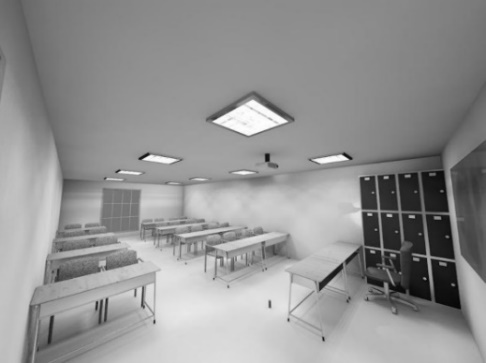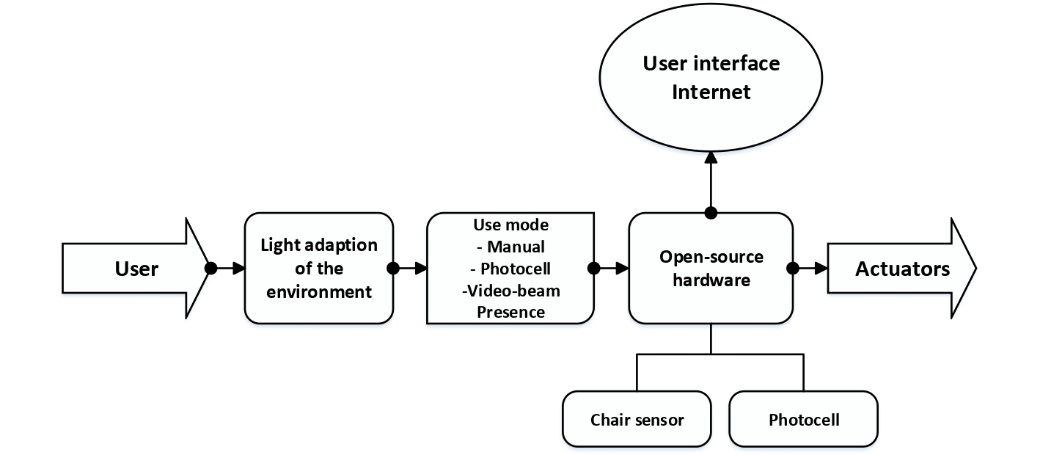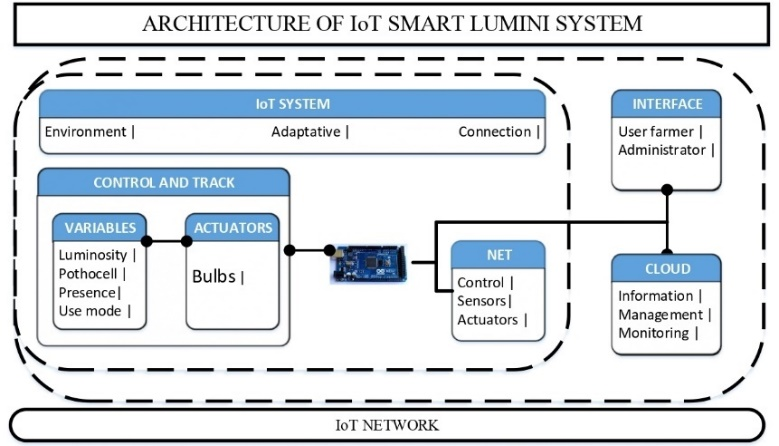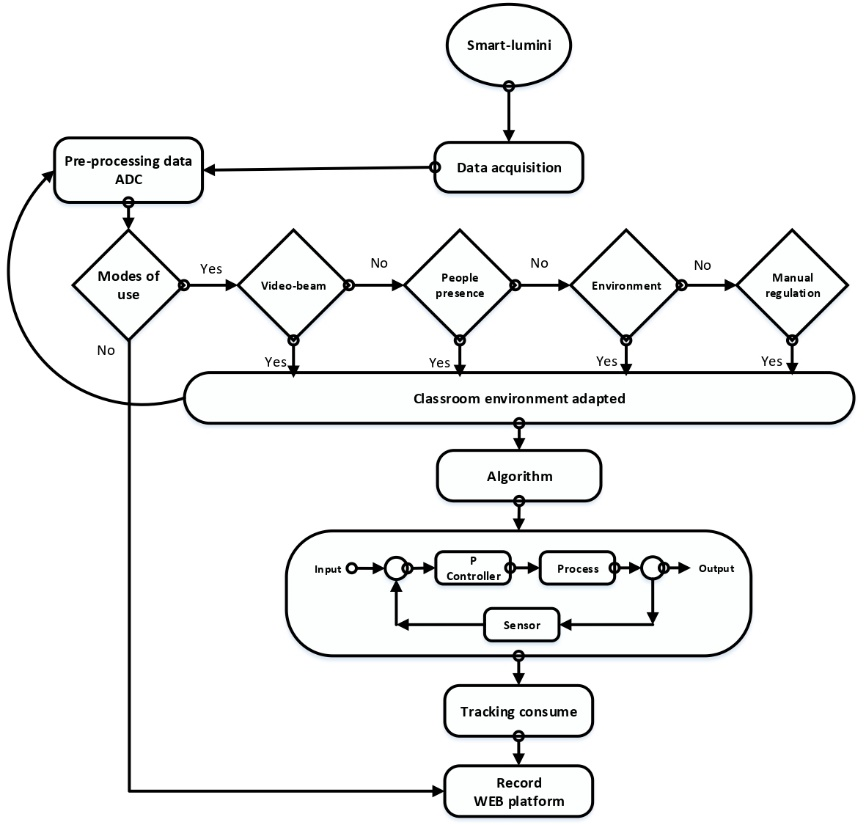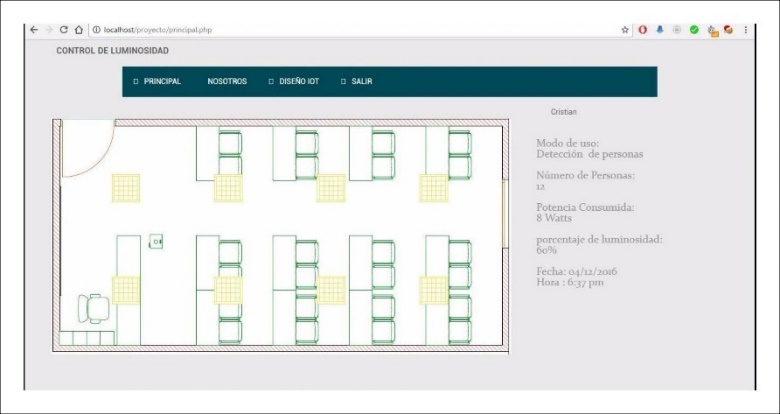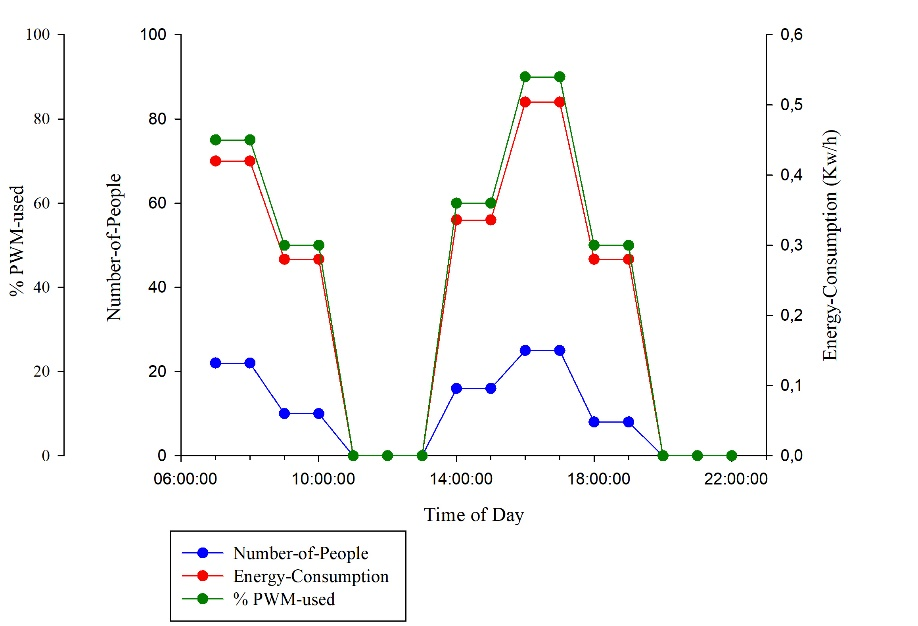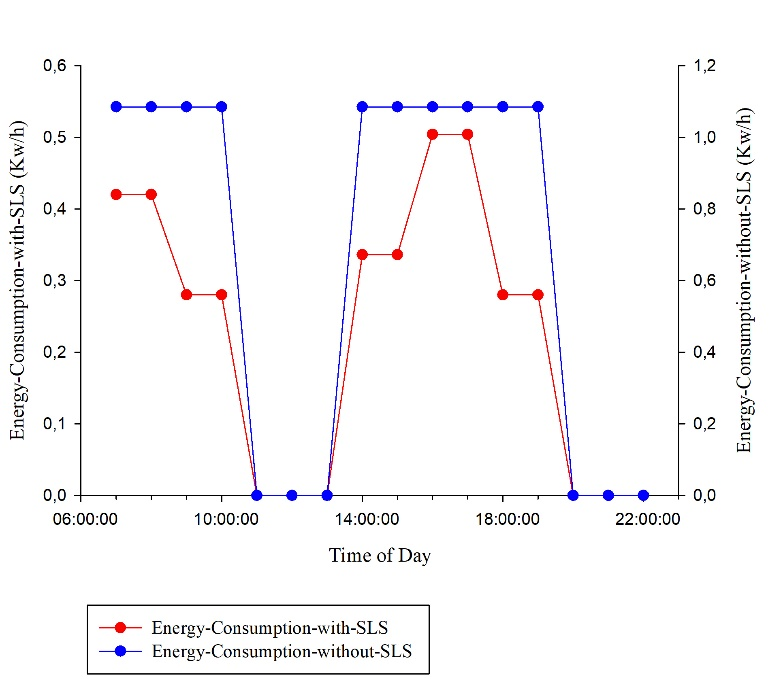I. INTRODUCTION
This document presents a smart system designed to control lighting at indoor locations, based on the paradigm of the Internet of Things (IoT), and using a university laboratory as a study case. The system aims to provide a set of physical devices arranged for lighting with autonomous, deploying, smart capabilities. Such capabilities will represent a subset of the IoT system intended to carry out the composition of services provided by smart things within a specific location. The objects endowed with functionality within the system are those commonly found in any classroom. The system’s application could be generalized with universal patterns for locations designed with academic purposes.
From the IoT perspective, a classroom has lightbulb things that, in addition to their conventional operation, are enriched with special capabilities to contribute to the Smart Lumini system. These include the ability to adjust the amount of lighting provided to a space and, therefore, the amount of electrical energy consumed, which tend to be considered smart things. The lighting sub-system is composed by i) sensors of presence at classroom chairs, with the purpose of determining the amount of electrical energy necessary for each singular location (smart thing: chair), transferable to the bulb things (smart thing: lightbulb). Next, ii) photocell sensor to determine the light intensity of the environment, which, together with a monitoring system, calculates the amount of additional electrical energy necessary to achieve an adequate and efficient lighting of the space. Last, iii) the system is managed from an interface that displays a menu with options for intervening in the whole lighting range according to the user’s needs.
Additionally, to provide personalization to the Smart Lumini system, the operation options were defined from analyzing systems as: 1) Presentation mode (when the location will be used for presentations with a video projector); 2) Photocell mode (this mode acts with a compensation to natural lighting, depending on the environment conditions); 3) Person detection mode (calculates the amount of lighting needed, according to the amount and distribution of people in the location); and, finally, 4) Manual range variation of lighting mode, throughout the location.
The variables measured and controlled by the system obey the relationship between amount of people and the efficient use of electrical energy. That is, the way in which the amount of people in a closed space influences the amount of electrical energy necessary to ensure a reasonable expenditure (from “green computing”: the rationalization of consumption principle). The natural light from the outside perceived in the closed space influences the amount of electrical energy necessary to ensure an adequate lighting. Therefore, awareness of rational use and user requirements will make a system intervention possible in different ways, such as setting a manual or automatic mode to modify the amount of electrical energy that will feed the system, options aimed at technological pedagogy to generate an environmental culture of saving and smart spending of electrical energy.
To guarantee the monitoring of the consumption rate, savings, and mode of use, the system has a user interface module that allows access in real time. The measurement of the variables involved is contained in a database, which will later be the object of mathematical calculations to obtain the energy consumed in Kw/h.
The research project promotes future works focused on the orchestration of services and technologies developed for the same case study, to complement the intelligent character of several enhanced elements, such as 1) teacher recording and tracking system; 2) smart door; 3) smart cabinets; and 4) smart ventilation. These things together make up a smart classroom as a holistic IoT system.
Technological innovation has greater deployment when its application is linked to the daily life of the user. The efficient use of electrical energy in Europe reveals the demand for buildings with technological intelligence, in order to reach an electricity consumption near to zero, by making the construction of EPBD (European Energy Performance of Buildings Directive) commercial offices and Universities a priority [1].
Comparative studies have been carried out using mathematical models to determine the efficient use of electric power in both, conventional and smart buildings [2]. As a result of this foregoing, the IoT is imposed as a paradigm that reduces the gap between understanding the technique of connecting things to the Internet and the possibility of developing smart environments [3, 4]. In this way, things have become functional objects in technologically adapted environments with an infrastructure based on hardware and software, to track the object or system in real time with a cloud domain [5, 6].
In Greece, environmental sustainability in public buildings dedicated to education is a technological reference available universally, making use of opensource technologies [7]. The essence of IoT enhances the access to information and the real time monitoring produced by Internet access. In the design of intelligent environments, domains are proposed for the representation of ambient intelligence [8]; these elements will ensure the intelligent environment and the management of the resource under technological control [9].
The monitoring and control of energy consumption, (in direct consumption elements, LED IoT bulbs) [10], has become an influential factor in industry, production, and manufacturing efficiency; and in areas of human development such as agriculture, mobility, industry, M2M (machine to machine), telemedicine, biomedicine, intelligent buildings, etc. [11]. The Internet of Things projects smart cities, smart microenvironments where millions of users can fit in well [12, 13]. It is a technology capable of guaranteeing immediacy and universality in the monitoring of resources [14].
Technological intervention in buildings is a step forward in reducing energy consumption and greenhouse gas emissions [15]. For example, the case of a predictive study on related electricity consumption in [16] that links nineteen cities in the USA and 763 buildings, using variables such as location sector or socioeconomic stratum. In Italy, the evaluation of energy performance of buildings is done by means of a simplified calculation, a semi-stationary and dynamic software applied to measure energy consumption [17].
The energy policies of the European Union (EU) determine a concept for indoor lighting techniques. Some works study the luminosity that a light bulb provides to interiors in terms of duration time per unit area [18]. Artificial intelligence uses historical data to predict and resolve the optimal electrical energy consumption in multiple buildings, based on multiple linear regressions, artificial neural networks, and vector support machines or prediction methods [19].
The fields under review made it possible to develop concepts and enhance technological initiatives around the development of software, hardware, and implementation of free development platforms [20-21].
This document contains a review of the state of the art, a general description of the system from the perspective of IoT, its functionality, technological design, relation of variables, and the elements that compose the system. Finally, the system is evaluated.
II. METHODOLOGY
The development of the project was aimed to influence the efficient use of electric energy in spaces dedicated to academia, in this case, a classroom. The smart object on which the system is centered is a bulb, enhanced with a sensor of the luminosity intensity of the sector in which its emission has influence. The next determining object in the system is the chair at each work desk. Taking into account each work space at the laboratory in the study case, where desks have between two and four chairs respectively, and each one has a personal presence sensor that will inform the system about the number of people that should be provided with lighting, to guarantee an adequate service.
The technique used to modify the amount of electric energy supplied to the lamp is the Pulse-Width Modulation (PWM), which will determine the amount of illumination of each sector; this is a variable that depends on the number of people present at each desk and the establishment of a minimum value programmed by the user.
Given that the system has four use functions, the subsystems that make up smart lighting control will be described below.
First, a system of logical relationships between sensors and actuators was developed. The photocell sensor evaluates the light conditions that influence the external environment. The classroom-laboratory taken as study case has two accesses or sources of natural light: the window and the access door. These two sources of light are measured to determine the amount of electrical energy necessary to supply the system, an action determined by the lamp actuator. The classroom was modeled at actual size, considering the authentic distribution of the furniture and its physical layout, as shown in Figure 1.
Second, a network of sensors installed in the chairs of the classroom was developed, all related to each other. The topology of the network is a mesh with centralized distribution. The communication network uses the ESP8266 module natively through the IPv4 addressing scheme that allows the interconnection to send and receive information about the status of their variables. The problem to overcome in this aspect is the routing and permanent connection of sensors with the MEGA platform through the Wi-Fi protocol. This was solved by ensuring the permanent update of master-slave between the MEGA and each sensor.
In other words, the pulse width programmed by the user in the system, may be the minimum or maximum energy required to ensure the lighting of the lamp for one person in the classroom space of 200 m2. This energy is necessary to ensure the illumination of the 8 lamps for 25 people on 25 chairs (maximum capacity of the space). This is the criterion of the relationship between presence of people sensors in the classroom and the quantity of programmed pulse width.
Third, the capacity of the Arduino MEGA platform (free hardware platform used) is sufficient to ensure down to the last detail the logical and algorithmic relationship of the measured variables and the actions executed by the actuators. Consequently, software design and electronic instrumentation focuses on the scalability of the system.
Fourth, since it is essential to be able to access or intervene in the system or in the code, to adapt or modify parameters, the user interface platform enables execution of the two possible modes of intervention by the user. The first intervention option is focused on information, such as electricity consumption, the way that the system is used, and the number of people who make use of the space. The second option is the modification of the reference-point or minimum amount of electrical energy that facilitates illumination according to the preference of the user.
In general, the functionality of the system is designed, first, to generate an environmentally positive impact; second, to generate an impact on the behavior and culture of electricity consumption of users in academic spaces; and third, to provide a degree of intelligence and technological autonomy to spaces, ensuring environmentally-friendly possibilities and vital relations geared towards the efficient use of electric energy.
The system designed within the IoT paradigm adapts characteristics in the management of technical and technological resources that, related and networked, provide information. Thereby it acts according to the state of the variables subject to control, in an environment endowed with intelligence and universal purposes of Internet access for the control and monitoring of a certain space used by certain people.
In the IoT design, the lighting control system based on IoT adopts the bulb as a smart object and features devices that are linked using an Arduino MEGA microcontroller. This guarantees the amount of electrical energy supplied to the bulb and, therefore, the luminosity in the space, with an element of control, monitoring, and access to the system via Internet. The objects and sensors that are orchestrated in the intelligent light control system, called Smart Lumini, are illustrated in the block diagram in Figure 2.
In the controlled environment, the chair adopts the function of generating the signal or variable, specifically the presence or absence of people. This data is transmitted to the system processor, the Arduino MEGA microcontroller, using the ESP8266 Internet connection device. These elements are the base of the interface platform.
The electrical circuit comprises two stages: i) the power stage and ii) the digital stage. The digital stage contains the hardware to intervene in the variables and subsystems that are part of the smart lighting system. The power stage describes the assembly that presents a decoupling of AC (alternating current) and DC (direct current) electrical energies. This configuration ensures that the amount of electrical energy supplied to each bulb varies using a single-phase phase cut-off.
The location, functionality, and orchestration of sensors and actuators are focused on the user, which is why the distribution of the system is strategic, ensuring the focus on the service to the teacher, students, and the environment. For this reason, the system requires an interface to let a direct access. Table 1 shows the relationship of assigned pulse width according to the number of people present in the classroom.
Table 1. Relation between pulse width and people quantity.
| Row | Persons | PWM% |
| 1 | 0 | PWM Min |
| 2 | 1 | PWM 50% |
| 3 | 2 | PWM 60% |
| 4 | 3 | PWM 75% |
| 5 | 4 | PWM 90% |
The scaled-up implementation has the characteristics established for the system. This distribution allows the research team to manage a spatial concept of distribution of the energy system, which guarantees the symmetric division of the pulse width needed for each lamp, in addition to emulating the real infrastructure of the laboratory used in the study case.
The smart lighting control system bases its concept on the architecture in Figure 3, in which the structural layers are analyzed, to determine critical factors such as the orchestrated operation between sensors, actuators, and the Internet connection, a set that ensures a smart environment connected to the Internet. The context, the state of the object, the location, and the identity regulate the technological scheme within the IoT framework.
Identity: the smart object is identified with the IP address of the module connected to the network (ESP8266) installed at the smart objects, lamps, and chairs.
Location: the system is in the RA building at the UPTC University campus, Classroom 305, Tunja headquarters, Colombia.
State: the variables to be measured in the system are light intensity, presence or absence of people, and the amount of incident ambient light in the classroom.
Context: the lightbulbs’ settings are related to smart objects as chairs, photocells, and the ambient luminosity that comes from sources outside the classroom.
III. RESULTS
The luminosity control system is automatic and constant in the monitoring and management of electrical energy in the laboratory. It is always determined by the presence or absence of people. The diagram shown in Figure 4 presents the workflow for the case in which input variables suffer changes according to the function of the system. Equation (1) gives the expression that governs the behavior of the algorithm responsible for the distribution of electrical energy in the system.
The Algorithm block in the diagram executes the code that uses the formula for people counting and directs the order to the corresponding actuator of the sector where the energy modification occurred.
The block Algorithm can identify which is the requested position in the classroom and orient the control commands to the actuators. By means of routing, the system associates the respective controller with the power stages of each bulb. All the controllers are of the same nature: only the changes in the number of positions (chairs) are monitored and controlled.
The equation shown above indicates the amount of energy distributed in the work zones, determined by i, which is the number of people in the workstations; its maximum will be 4. The letter a indicates the percentage of illumination corresponding to the number of people per zone, then n, the luminosity of the external environment with an influence on the adapted system, is subtracted. Finally, k indicates the total of the range of lighting in which the classroom is currently programmed. This lighting parameter k is subject to constant modification by the users of the system: teacher, or students, according to requirements. The Tracking block, on executing the proportional controller for each actuator (Bulb), stores the consumption records, and displays the data in the user interface.
The system intelligence provided the classroom with a functionality according to the calculations of space and energy necessary for the academy to operate. The four established modes of use, the two functions and their characteristics are described below.
Video-beam mode: this mode establishes low lighting levels in all lamps, the teacher has the option to access and modify the term of energization of the lamps with the variation of the pulse width that supplies the electrical energy to the system.
Presence and absence of people mode: the intensity of the light varies according to the number of people that occupy the classroom in the work desks. This luminosity control by the number of people works due to infrared sensors installed in the chairs, to guarantee the logical state necessary for the lighting control of the place.
Environment mode: the brightness of the classroom is influenced by ambient light from outside the classroom, thanks to the photoelectric sensor (photocell), which is sensitive to changes in ambient light intensity. This mode adjusts the system automatically to determine its consumption state.
Regulation or reference change mode: the base lighting that the system supplies to the classroom could be considered insufficient by students or teachers, so it is possible to access the system, by username and password, to modify that reference to a personalized level.
This system has a user interface (web page), developed to control the lighting of the classroom and to follow the amount of energy consumed by the lamps. It also determines how much energy is being used in each of the operating modes in real time. This information on electricity consumption is stored in a database, to keep historical records of electricity consumption.
A. Technologies and Electronic Design
The implementation of the system presents instrumentation techniques to ensure data collection and measurement of variables by sensors and intelligent objects. The instrumentation of the devices is designed according to the nature of the signals emitted by the sensors or intelligent things orchestrated in the system as in [22], the signals processed in the system are of analogical type (photocells) and digital type (the chairs). The calculation of the luminosity of the space was done through the number of lumens provided by each LED lamp and its relationship with the size of the space in m2.
B. Description of the Developed Web
The design and development of the website is implemented with the technique of (backend and frontend), these were adapted to perform the actions of control and change user parameters of the system, or vice versa.
Backend: this is the work from the server, it involves the creation of a MySQL database (open source database software), a JavaScript programming language under Node.js, operated with a npm package manager to connect to the database in real time. This set allows the development of an algorithm to monitor and supervise the consumption of electrical energy, storing the information in the database with cloud transaction.
Frontend: this part of the platform is responsible for the design that is shown to the user (in this case, the administrator) as the final product. The development of the structure is composed by HTML5 (Hypertext Markup Language), referring to the demarcated language for the development of the page, CSS3 (Cascading Style Sheets), where the styles of the website are modified by changing the design parameters and making the page visually more pleasing to the user. It is complemented with JavaScript to add the experience and interaction with the user. The final interface product was designed with emphasis on usability and presentation. The central tracking page is shown in Figure 5, where a menu with the system information is displayed.
The user login to the platform requires a username and a password that is validated from the database by the administrator, providing the system with a certain level of security, to have unique user access.
The main page of the application features the diagram of the distribution of the room (top view) and information on the status of functionality; the total consumed power, the number of people in the room, and the total consumption of each of the led bulbs, feeding at the same time the database that is hidden from the user.
IV. DISCUSSION
The behavior of the Smart Lumini System (SLS) implemented in the classroom allowed us to evaluate and analyze energy consumption. We can obtain 10 days of data, but we only present one day of results here. These measurements, recorded and stored on the application database, can be graphed for further analysis. Table 2 shows the primary data to interpret the analysis. The measure of energy consumption is in Kw/h per month, the costs vary according to the number of bulbs used and the time of use.
Table 2. Energy Consumption of the Classroom without SLS.
| Bulbs | Power (Watts) | Usage Hour/Day | Consumption KW/h per Month | Kw/h Price (€) |
| 1 | 7 | 15 | 3.255 | 0.17 |
| 8 | 56 | 15 | 26.04 | 4.426 |
Table 3 shows the data measured with the Smart Lumini System implemented in the classroom. These data, as the above table, present the economic costs in euro (€). Thus, we can see the money saved with the implementation of SLS. Nevertheless, for greater clarity, Table 4 shows a more detailed example of energy consumption on an ordinary day. These data contain the PWM% used by the bulbs, the SLS mode of use, the number of SLS users, and the number of lightbulbs involved in lighting the room.
Table 3. Energy Consumption of the classroom with implementation of SLS.
| Bulbs | Power (Watts) | Usage Hour/Day | Consumption KW/h per Month | Kw/h Price (€) |
| 1 | 7 | 10 | 1.68 | 0.17 |
| 8 | 56 | 10 | 13.44 | 2.486 |
As seen in Table 4, the variables related to the bulbs involved in the SLS, like the PWM%, system mode of use, and the number of present people, make the bulbs coordinate the orchestration and choreography into the IoT ecosystem. Thanks to this feature, we can say that our system is adaptative.
Table 4 presents some data related to the one-day operation of SLS. Hereunder, in Figures 6 and 7, the classroom behavior is graphically represented with SLS. In Figure 6, we can see that the number of people determines the consumption of energy apart from the performance of the SLS mode of use, a fact that makes it possible to configure an adaptative system to guarantee a smart brightness.
Table 4. Information of the Energy Consumption in the classroom.
| Time/Hour | People | QBulbs | (Kw/h)/Month | Usage Mode-SLS | %PWM-Used |
| 07:00 | 22 | 6 | 0.42 | 3 | 75 |
| 08:00 | 22 | 6 | 0.42 | 3 | 75 |
| 09:00 | 10 | 4 | 0.28 | 1 | 50 |
| 10:00 | 10 | 4 | 0.28 | 1 | 50 |
| 11:00 | 0 | 0 | 0 | 2 | 0 |
| 12:00 | 0 | 0 | 0 | 2 | 0 |
| 13:00 | 0 | 0 | 0 | 2 | 0 |
| 14:00 | 16 | 5 | 0.336 | 2 | 60 |
| 15:00 | 16 | 5 | 0.336 | 2 | 60 |
| 16:00 | 25 | 7 | 0.504 | 4 | 90 |
| 17:00 | 25 | 7 | 0.504 | 4 | 90 |
| 18:00 | 8 | 4 | 0.28 | 1 | 50 |
| 19:00 | 08 | 4 | 0.28 | 1 | 50 |
| 20:00 | 0 | 0 | 0 | 2 | 0 |
| 21:00 | 0 | 0 | 0 | 2 | 0 |
| 22:00 | 0 | 0 | 0 | 2 | 0 |
Figure 7 shows the difference between the energy consumption in the classroom with and without SLS implementation. This graphic expose that the IoT ecosystem adapted to users, reduces expenses, acts according to the user’s needs, and later mitigates environmental impact. For this reason, a system like this, due to its low cost, open-ended (free hardware), and easy implementation, can be an excellent option to save energy.
A system like this, as seen in Figure 7, allows saving more than 60% of energy consumption. The energetic waste from misuse in academic facilities (universities) is extremely high, but this proposal can help to manage the energy.
V. CONCLUSIONS
The Smart Lumini System implemented in the classroom, demonstrated high performance in adapting to user needs according to external variables that influence classroom lighting. The quantitative results showed the amount of electrical energy saved and how much it translates into economic cost. The designed controllers showed high efficiency, and the IoT system, in general, showed an excellent performance in terms of stability and reliability. In kw/h per month, the system can save more than 60% of energy about the usual consumption.
The challenge imposed by the modern constructions is possible, and a modification of structural type is plausible, where the principle of efficient use of electric power is a priority parameter in the design. For this reason, and due to the current conditions of the academic environment, emphasis was placed on the development and technological capacity appropriate to those spaces.
Some studies carried out in buildings dedicated to academic service show that the excess of electricity consumption is found in non-working hours, due to factors of different nature. Therefore, the smart lighting system mitigates the improper use of specific devices and supports the administration of spaces regarding energy.
IoT is imposed as a paradigm that reduces the gap between understanding the technique of connecting things to the Internet and the possibility of developing intelligent environments. Things, thereby, become functional objects participating in technologically adapted environments with infrastructure based on hardware and software. An intelligent classroom, such as the one designed in this project, explores technological and technical management alternatives that mitigate waste and eliminate the culturally constructed stigma around unfeasible architectural infrastructure. This development can be easily adapted to any electrical system thanks to the resources provided by the area of electronics.














